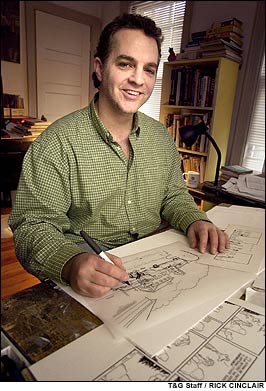|
Producing daily strip grueling work

Tuesday, March 5, 2002
By Pamela H. Sacks
Telegram & Gazette Staff
Producing@ BRIGHTON-- Peter Murphey knew exactly where he wanted
his career as an artist to take him: straight to the comic pages.
Over several years, Mr. Murphey tried a couple of wacky ideas for
comic strips, one having to do with a reptile ranch and another
about a Martian stranded on Earth. He got enough rejection letters
to, as he put it, “to wallpaper a room with.”Then Mr.
Murphey came up with “Hippy and Pop,” two characters of
a type far more familiar to a broad swath of Americans.Hippy is
a ponytail-sporting baby boomer with '60s sensibilities trying to
co-exist with his cranky, divorced father, who has moved in. Hippy
also has a congenial wife, a 7-year-old daughter who hates tofu
and adores Britney Spears and a mother seeking the perfect second
husband.Mr. Murphey, 40, knew the characters would resonate with
members of the “sandwich” generation, who cope with the
pressures of caring for aging parents while raising children. Nonetheless,
he was stunned when he got a call in August from Jay Kennedy, editor
in chief of King Features Syndicate Inc., delivering the news: “We
want to syndicate you.”Mr. Murphey's strip was one of two or
three selected from about 6,000 submitted to the syndicate in 2001.
“It's a well-crafted strip with a number of points
of entry for many people,” Mr. Kennedy explained the other
day. “He's a clever writer.”Naturally, Mr. Murphey, who
was born and raised in Worcester, was thrilled.But he was also horrified,
as he soon realized that he had just over two weeks to pull together
all of the art for a presentation at a sales meeting at King Features'
Manhattan headquarters in early September.“I had to work on
it almost day and night,” Mr. Murphey recalled.That, of course,
was just the beginning of what could only be described as a grueling
schedule. “Hippy and Pop” first appeared Jan. 7 and is
published seven days a week.The strip is witty and spiced with cynicism.
Mr. Murphey works on it in his small, cluttered studio half a flight
of stairs down from his apartment in a duplex in the Brighton section
of Boston. He has to stay six weeks ahead, which keeps him working
flat out sometimes seven days a week.Bill Watterson, the creator
of “Calvin and Hobbes,” has been an inspiration; Mr. Murphey
keeps a book collection of the strip, a chronicle of a 6-year-old
boy's psyche, on a cabinet near his drawing board. Mr. Watterson
produced “Calvin and Hobbes,” which was carried in 2,400
newspapers, from 1985 to 1995. At that point, he announced he had
run out of steam and would pursue work with “a more thoughtful
pace.” Mr. Murphey can understand. He remarked in his easygoing
way that coming up with clever themes week after week is as difficult
as it would seem. He has trays filled with scraps of paper containing
ideas and sketches. The most developed ones are on the top of the
pile. As he starts to draw, new schemes often come to him. The finished
product is sent digitally to New York.“You have to be demented
in a certain sort of way to do this every day,” he said with
a laugh.Yet, dedication may not be quite enough. Mr. Murphey noted
wryly that his strip is “hanging on by its claws” and
may soon be canceled.The timing of its introduction was unfortunate,
Mr. Kennedy, the King Features editor, said. The official sales
meeting was the week before the events of Sept. 11. The economy
tipped into recession, and most newspaper editors, grappling with
coverage of terrorism and the war in Afghanistan, were not in a
position to consider a new strip.“Hippy and Pop” has been
picked up by eight newspapers across the country. They range from
small publications to the Seattle Post-Intelligencer, a major metro
daily. It is not sufficient distribution to make the strip financially
worthwhile for King Features or for Mr. Murphey.
“You need to have a critical mass early on in
order for it to be seen enough to have other editors take an interest,”
Mr. Kennedy said.
Mr. Murphey was not naive about the inherent difficulties
in selling a new comic strip.Editors think long and hard before
pulling one strip to run another. It is a move that tends to set
off howls of complaint, because even if a comic strip appears outdated
or to have run its course, it invariably has a core group of fans.On
top of that, newspapers are running on tighter budgets than they
used to.“I've had syndicate editors who said, 'If you had done
it 10 years ago, we would have snapped it up. There was more leeway
then,' ” Mr. Murphey said.
Of the tiny number of comic strips accepted for syndication,
a third will fail.Mr. Murphey became an artist by default, so to
speak. He laughed when he recounted that while attending Doherty
Memorial High School on Worcester's West Side, he thought, for no
clear reason, that he was destined to be a professional baseball
player. He got injured in his junior year and turned to drawing
for solace.It was a natural inclination. As a child he enjoyed all
sorts of creative activities -- drawing, puppetry, magic -- and
his parents were encouraging. His father, John, who lives in Leicester,
teaches art and art history at the Leicester campus of Becker College.
His mother, Marilyn, a dancer, resides in Worcester.The turning
point for Mr. Murphey came when he entered an ink drawing of a tightrope
walker in a contest sponsored by The Boston Globe. He came in third,
a significant achievement, and it emboldened him to consider art
as a vocation.Mr. Murphy went on to study painting at the Massachusetts
College of Art in Boston. He loved it, but found that whenever he
had free time, he fiddled around with comics and illustration.In
need of an income after graduation, he turned to commercial art
and got into drawing caricatures, which became a specialty. Two
clever examples, one of President Bush as a wrestler and another
of political commentator Mark Shields, decorate the walls of his
studio.Even with the pressures of producing “Hippy and Pop,”
Mr. Murphey continues to do free-lance work, from magazine illustrations
to animation. He also books caricature artists for special events
through his company, Murph Productions.
“I don't sleep too often,” he remarked, appearing a little
weary. “At the moment, I do way too much stuff.”But the
real challenge right now is to pull away emotionally from “Hippy
and Pop,” while continuing to produce quality strips.“I
was thrilled to get syndicated,” Mr. Murphey said. “I
love doing it. It suits me well. I'm getting to the point where
I know the characters and like them pretty well. But I've gotten
used to the idea that it may not fly.”If the comic strip is
canceled, he will walk away having discovered that he is a talented
writer. Without that, a strip is doomed.
“Good writing can carry weak art,” Mr. Kennedy said,
“but weak writing can't carry good art.”And Mr. Murphey,
who describes himself as “aggressively persistent,” would
try another comic strip, but not before he takes a long break. He
would start with a leg up, Mr. Kennedy said.
“Creating an idea and presenting strips for consideration
is one thing,” Mr. Kennedy said. “Delivering day in and
day out over an extended period of time is another. Pete has proven
himself.”
Meanwhile, there are always other interesting artistic outlets
worth testing. The other day, Mr. Murphey was on the Web site for
The New Yorker perusing the magazine's cartoons.
“I thought, 'I should take a crack at this,' ” he said,
with a broad smile.
|

